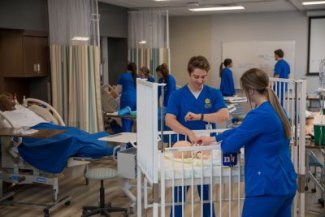
A primary component of nursing education is the clinical experience. Students participate in supervised learning sessions in real world healthcare environments, which provide them with the opportunity to put what they’ve learned in the classroom into practice. One of the many advantages of enrolling in the SDSU nursing program is that students complete over 750 hours of clinicals in the practice setting. These hours include acute hours, community hours and time spent in simulation. Our program combines the unique resources of the SDSU campus with outside healthcare agencies in a manner that enables students to participate fully in all facets of the healthcare delivery system.
On-campus clinical learning
Each College of Nursing site has a Healthcare Simulation Center, a clinical practice laboratory and technology-enhanced classrooms. South Dakota State University College of Nursing Healthcare Simulation Center has provisional accreditation by the Society for Simulation in Healthcare in the areas of teaching and education. The center is one of 146 healthcare simulation programs accredited by the Society and is among the first land-grant institutions to receive this accreditation.
During simulation, students work with a variety of patient simulators (high tech mannequins) of varying ages and backgrounds. The patients present with a variety of health conditions. They can talk, breathe, simulate human heartbeat and more. We lovingly call these patients the “Jackson Family”. Students will get to know each patient in a manner that makes them come alive.
Off-campus clinical learning
Off campus, students participate in increasingly complex clinical experiences at some of the best-known healthcare entities in the region. These experiences take place in a variety of settings across the healthcare continuum and are supervised by preceptors, who are caring and experienced practitioners and educators. Students complete their clinical learning in major hospitals, community clinics and other health facilities in the region. The variety of settings helps to prepare students to interact appropriately and effectively with patients from all walks of life.

